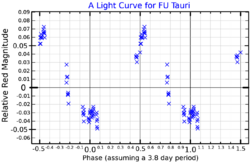Astronomy:FU Tauri
| Observation data {{#ifeq:J2000|J2000.0 (ICRS)|Epoch J2000.0 Equinox J2000.0 (ICRS)| Epoch J2000 [[Astronomy:Equinox (celestial coordinates)|Equinox J2000}} | |
|---|---|
| Constellation | Taurus |
| A | |
| Right ascension | 04h 23m 35.3912s[2] |
| Declination | +25° 03′ 02.74″[2] |
| Apparent magnitude (V) | |
| B | |
| Right ascension | 04h 23m 35.3912s[3] |
| Declination | +25° 03′ 02.74″[3] |
| Apparent magnitude (V) | |
| Characteristics | |
| Spectral type | M7.25 + M9.25[4] |
| Apparent magnitude (G) | 15.2[2] + 20.5[3] |
| Variable type | T Tau[5] |
| Astrometry | |
| A | |
| Proper motion (μ) | RA: 6.895[2] mas/yr Dec.: −21.026[2] mas/yr |
| Parallax (π) | 7.5981 ± 0.1497[2] mas |
| Distance | 429 ± 8 ly (132 ± 3 pc) |
| B | |
| Proper motion (μ) | RA: 12.450[3] mas/yr Dec.: −21.761[3] mas/yr |
| Parallax (π) | 7.4909 ± 1.2887[3] mas |
| Distance | approx. 440 ly (approx. 130 pc) |
| Details | |
| A | |
| Mass | 0.05[6] M☉ |
| Radius | 1.8[6] R☉ |
| Luminosity | 0.2[4] L☉ |
| Temperature | 2,838[4] K |
| Age | ≤1[6] Myr |
| B | |
| Mass | 0.015[6] M☉ |
| Luminosity | 0.0039[4] L☉ |
| Temperature | 2,375[4] K |
| Age | 1[6] Myr |
| Other designations | |
| Database references | |
| SIMBAD | A |
| B | |
FU Tauri is a brown dwarf binary system in the constellation of Taurus about 429 light years away. The secondary is very close to the lower limit for brown dwarfs and several databases list it as a distant massive exoplanet.
System
The two stars of the FU Tauri system are separated by 5.7″, equivalent to 800 astronomical unit|AU at the distance of FU Tauri.[7] The primary is a brown dwarf with a mass of 0.05 M☉, while the secondary has a mass of 0.015 M☉. The secondary mass of 15 MJ is close to the dividing line between brown dwarfs and exoplanets, and it is often treated as an exoplanet.[8]
Properties
Both members of the binary are low-mass objects still contracting towards the main sequence. Comparison with theoretical evolutionary tracks gives them ages of one Myr or less. However, the primary is more luminous than expected even for this age and it may be younger than the secondary.[6] The primary has a temperature of 2,838 K, a radius of 1.8 R☉, and a bolometric luminosity of 0.2 L☉. The secondary has a temperature of 2,375 K and a bolometric luminosity of 0.0039 L☉.[6]
Variability
FU Tauri varies in brightness. The primary star is a T Tauri variable, a type of irregular pre-main-sequence star. Its brightness has been observed to vary from a photovisual magnitude of 16.0 to fainter than 17.0.[9] Its photographic magnitude has been measured to vary between magnitude 15.1 and below magnitude 17.6.[10]
References
- ↑ Scholz, Alexander; Stelzer, Beate; Costigan, Grainne; Barrado, David; Eislöffel, Jochen; Lillo-Box, Jorge; Riviere-Marichalar, Pablo; Stoev, Hristo (January 2012). "Magnetic activity and accretion on FU Tau A: clues from variability". Monthly Notices of the Royal Astronomical Society 419 (2): 1271–1279. doi:10.1111/j.1365-2966.2011.19781.x. Bibcode: 2012MNRAS.419.1271S.
- ↑ 2.0 2.1 2.2 2.3 2.4 2.5 Brown, A. G. A. (August 2018). "Gaia Data Release 2: Summary of the contents and survey properties". Astronomy & Astrophysics 616: A1. doi:10.1051/0004-6361/201833051. Bibcode: 2018A&A...616A...1G. Gaia DR2 record for this source at VizieR.
- ↑ 3.0 3.1 3.2 3.3 3.4 3.5 Brown, A. G. A. (August 2018). "Gaia Data Release 2: Summary of the contents and survey properties". Astronomy & Astrophysics 616: A1. doi:10.1051/0004-6361/201833051. Bibcode: 2018A&A...616A...1G. Gaia DR2 record for this source at VizieR.
- ↑ 4.0 4.1 4.2 4.3 4.4 Luhman, K. L.; Mamajek, E. E.; Allen, P. R.; Muench, A. A.; Finkbeiner, D. P. (2009). "Discovery of a Wide Binary Brown Dwarf Born in Isolation". The Astrophysical Journal 691 (2): 1265. doi:10.1088/0004-637X/691/2/1265. Bibcode: 2009ApJ...691.1265L.
- ↑ Samus, N. N. et al. (2009). "VizieR Online Data Catalog: General Catalogue of Variable Stars (Samus+ 2007-2013)". VizieR On-line Data Catalog: B/GCVS. Originally Published in: 2009yCat....102025S 1: B/gcvs. Bibcode: 2009yCat....102025S.
- ↑ 6.0 6.1 6.2 6.3 6.4 6.5 6.6 Stelzer, B.; Scholz, A.; Argiroffi, C.; Micela, G. (2010). "The enigmatic young brown dwarf binary FU Tau: Accretion and activity". Monthly Notices of the Royal Astronomical Society 408 (2): 1095–1102. doi:10.1111/j.1365-2966.2010.17182.x. Bibcode: 2010MNRAS.408.1095S.
- ↑ Monin, J.-L.; Whelan, E. T.; Lefloch, B.; Dougados, C.; Alves De Oliveira, C. (2013). "A molecular outflow driven by the brown dwarf binary FU Tauri". Astronomy & Astrophysics 551: L1. doi:10.1051/0004-6361/201220973. Bibcode: 2013A&A...551L...1M.
- ↑ "FU Tauri". http://www.openexoplanetcatalogue.com/planet/FU%20Tau%20B/.
- ↑ Romano, G. (1975). "Observations of T Tau stars and related objects in Taurus dark cloud". Memorie della Societa Astronomica Italiana 46: 81. Bibcode: 1975MmSAI..46...81R.
- ↑ Gotz, W. (1961). "Photographische Untersuchungen an RW Aurigae-Sternen in den Dunkelgebieten von Taurus und Orion". Veroeffentlichungen der Sternwarte Sonneberg 5: 87. Bibcode: 1961VeSon...5...87G.
 |


